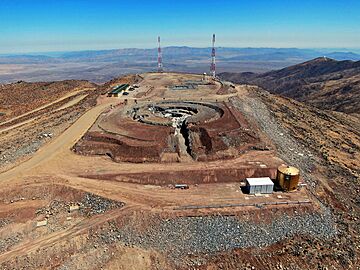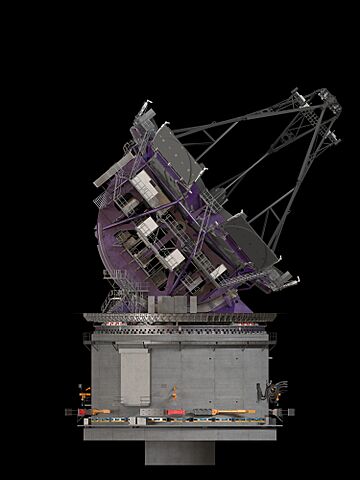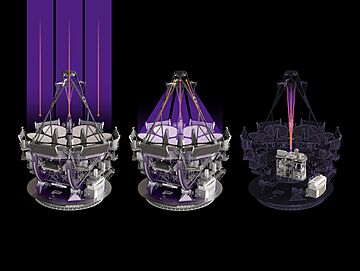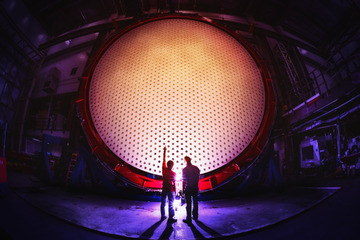Giant Magellan Telescope facts for kids
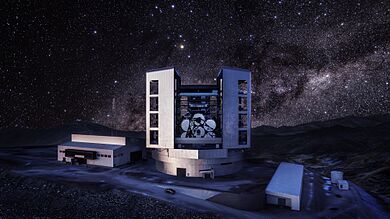 |
|
| Alternative names | GMT |
|---|---|
| Location(s) | Chile |
| Coordinates | 29°02′54″S 70°41′01″W / 29.0483°S 70.6836°W |
| Altitude | 2,516 m (8,255 ft) |
| Wavelength | 320 nm (940 THz)–25,000 nm (12 THz) |
| Built | 2015– |
| Diameter | 25.448 m (83 ft 5.9 in) |
| Secondary diameter | 3.2 m (10 ft 6 in) |
| Mass | 2,100 t (2,100,000 kg) |
| Collecting area | 368 m2 (3,960 sq ft) |
| Focal length | 18, 202.7 m (59 ft 1 in, 665 ft 0 in) |
| Website | giantmagellan |
| |
|
The Giant Magellan Telescope (GMT) is a huge telescope being built on the ground in Chile. It is located at the Las Campanas Observatory in the Atacama Desert. When finished, it will be one of the largest telescopes ever made.
The GMT will have a main mirror that is 25.4 meters (about 83 feet) wide. It will use seven very large mirrors to collect light. This will give it a light-collecting area of 368 square meters. The telescope will be able to see in both visible light and infrared light.
Scientists expect the GMT to be about 10 times more powerful than the Hubble Space Telescope. It will also be four times stronger than the James Webb Space Telescope. However, it cannot see the same infrared light as space telescopes. The GMT will help scientists look for signs of life on planets outside our solar system. It will also help them study how chemical elements first formed in the universe.
Work on the GMT's main mirrors started in 2005. Construction at the telescope site began in 2015. By 2023, all seven main mirrors were cast. The first of seven special secondary mirrors was being built. The large structure that holds the telescope was also being made. Other parts of the telescope were in their final design stages.
The project is expected to cost about $2 billion. It is being built by the GMTO Corporation. This group includes research centers from seven countries. These countries are Australia, Brazil, Chile, Israel, South Korea, Taiwan, and the United States.
Contents
Where is the Giant Magellan Telescope located?
The Giant Magellan Telescope is being built at the Las Campanas Observatory. This observatory is also home to the Magellan Telescopes. It is located about 115 kilometers (71 miles) north of La Serena. The site is high up, at 2,516 meters (8,255 feet) above sea level. The Carnegie Institution for Science has owned this land since 1960.
Las Campanas was chosen because it has very clear skies. The weather is good for observing stars for most of the year. There are not many people living in the nearby Atacama Desert. This means there is very little air pollution or light pollution. These conditions make it one of the best places on Earth to study space for a long time.
Being in the Southern Hemisphere also helps. From this location, scientists can easily see important things in space. These include the center of our Milky Way galaxy. They can also see the closest supermassive black hole (called Sagittarius A*). Other targets include the closest star to our Sun (Proxima Centauri) and the Magellanic Clouds. Many nearby galaxies and exoplanets can also be studied.
How the Giant Magellan Telescope is designed
The Giant Magellan Telescope uses a special design called a Gregorian telescope. This design helps it create the clearest images of the universe. It uses only two main mirrors to collect light. This makes it very good at seeing a wide area of the sky.
The telescope can see light from 0.32 to 25 micrometers in wavelength. It has a wide view of 20 arcminutes. Its main mirror is 25.4 meters wide, covering 368 square meters. The telescope is designed to have a very sharp view, able to see details as small as 0.01 arcsecond at 1 micrometer.
Work to prepare the site began in March 2012. The first ground-breaking ceremony for construction happened in November 2015. A company called WSP was hired in January 2018 to manage the building of the telescope.
The first main mirror was cast in November 2005. Casting means pouring melted glass into a mold. The third mirror was cast in August 2013, the fourth in September 2015, the fifth in 2017, the sixth in 2021, and the last one in 2023. The first mirror was finished being polished in November 2012.
A company called Ingersoll Machine Tools built a factory in Illinois to make the telescope's mount. This factory was finished in December 2021. The telescope mount is currently being built. It is expected to arrive in Chile by the end of 2025.
The Telescope's Shelter
The Giant Magellan Telescope will be housed in a tall building. This building is about 65 meters (213 feet) high. It protects the telescope's mirrors and parts from bad weather and earthquakes. The Atacama Desert can have strong earthquakes.
This building weighs 4,800 tons. It can turn all the way around in just over three minutes. It also has a special air system. This system keeps the temperature inside the building steady. This helps the main mirror work its best.
The building's design also protects the telescope from earthquakes. It has a system that helps it survive very strong quakes. This system also allows the telescope to start working again quickly after smaller earthquakes. Smaller quakes happen several times a month. In March 2022, a company called IDOM was hired to finish the design of this building by 2024.
The Telescope's Mount
The telescope mount is the large structure that holds the mirrors. It is about 39 meters (128 feet) tall. It sits on a round base that is 22 meters (72 feet) wide. Without the mirrors and instruments, this structure weighs 1,800 tons. With them, it weighs 2,100 tons.
This huge structure floats on a thin layer of oil, about 50 microns thick. This allows the mount to move very smoothly without friction. This helps the telescope point accurately. In October 2019, GMTO Corporation hired two companies, MT Mechatronics and Ingersoll Machine Tools, to build this structure. As of 2022, the mount was being built and is expected to be finished in 2025.
The mount has seven "cells" that hold the main mirrors. Each mirror weighs 18 tons. The mount's strength comes from its unique shape and outer shell. This makes it strong, light, and stable. It helps the telescope resist wind and shaking. This ensures clear images.
The mirror support system uses "active optics." These are special devices that push on the back of the mirrors. They correct for changes caused by gravity and temperature. This keeps the images sharp. The system also has air units that circulate air. This helps keep the mirrors at a steady temperature.
A full-size test version of the mirror support system was built. This helped check the design and how well it would work. In April 2023, the first of seven mirror covers was finished. These covers will protect the mirrors when the telescope is not in use. They can close in just over two minutes.
The Main Mirrors
The GMT will use seven of the world's largest mirrors as its main mirror parts. Each mirror is about 8.4 meters (27.6 feet) wide. One mirror will be in the center. The other six will be placed around it in a circle. The outer six mirrors are special because they are "off-axis." This means they are not perfectly round like a normal mirror. This makes them harder to polish and test.
The mirrors are being made at the University of Arizona's Steward Observatory Richard F. Caris Mirror Lab. Each mirror is made from 20 tons of special glass from Japan. It takes about 12 to 13 weeks to cast (pour and shape) each mirror. After casting, they need to cool for about six months. It takes about 4 years to cast and polish each mirror. The surface is made incredibly smooth. The highest bumps and lowest dips are smaller than 1/1000th of a human hair's width.
Because these are off-axis mirrors, new ways of testing and polishing them had to be invented. The plan is to make seven identical off-axis mirrors. This way, there will be a spare. If one mirror needs to be cleaned or recoated, the spare can take its place. This cleaning process takes 1 to 2 weeks and is needed every 1 to 2 years. The telescope will start working with four mirrors first, then add the others.
The main mirror system will have a focal ratio of f/0.71. The whole telescope will have a focal ratio of f/8. Like other modern large telescopes, the GMT will use adaptive optics. This technology helps correct for blurry images caused by Earth's atmosphere.
Scientists expect the GMT to produce very clear images. This is because of its huge size and advanced adaptive optics. The images will be sharp enough to see a small detail like the torch on a U.S. dime from almost 160 kilometers (100 miles) away. The image quality is expected to be even better than that of the Hubble Space Telescope.
Secondary Mirrors and Adaptive Optics
The Giant Magellan Telescope's Adaptive Secondary Mirror has seven parts. Each part is about 1.1 meters (3.6 feet) wide. These mirrors are "adaptive optics" mirrors. They can change their shape very quickly to fix distortions caused by Earth's atmosphere.
Each part is a thin piece of glass. It is connected to over 7,000 tiny motors. These motors can reshape the mirror's surface 2,000 times per second. This corrects the blurring effect of the atmosphere. The first of these mirrors was being built as of August 2022 and is expected to be finished in 2024.
The Giant Magellan Telescope will have three ways to use adaptive optics:
- Ground Layer Adaptive Optics (GLAO): This system corrects for blurring caused by the lowest part of the atmosphere. It works over a wide area and makes images 20-50% clearer.
- Natural Guide Star Adaptive Optics (NGAO): This uses a single bright star to make very sharp, detailed images. It works well for small areas of the sky.
- Laser Tomography Adaptive Optics (LTAO): This uses six laser beams and one faint star. It helps the telescope see very sharp images across almost the entire sky. It works best for infrared light and a wider area than NGAO.
The Giant Magellan is the only telescope of its size that can use ground layer adaptive optics over its full view.
Science Instruments
The Giant Magellan Telescope can hold up to 10 different science instruments. These instruments can see light from visible to mid-infrared wavelengths. Some instruments can take wide-field images or study hundreds of objects at once. Others can take very high-resolution images. They can study exoplanets and even look for signs of life. Each instrument is designed to use the telescope's four observing modes.
The telescope will have an advanced fiber-optic system. This system uses tiny robots to move fibers. This allows the telescope to study many targets at once across its entire view. This helps scientists see fainter objects with amazing detail and sensitivity. It is very useful for measuring distances, movements, chemistry, and masses of objects far away in space.
Some of the main instruments include:
- GMT-Consortium Large Earth Finder (G-CLEF): An instrument that studies visible light.
- GMT Multi-object Astronomical and Cosmological Spectrograph (GMACS): An instrument that studies many objects in visible light at once.
- GMT Integral-Field Spectrograph (GMTIFS): An instrument that takes images and studies near-infrared light.
- GMT Near-IR Spectrograph (GMTNIRS): An instrument that studies near-infrared light.
- The Many Instrument Fiber System (MANIFEST): A system that uses fibers to connect instruments.
There will also be a Commissioning Camera (ComCam). This camera will help test how well the Ground Layer Adaptive Optics system works.
Scientists plan to use the Giant Magellan Telescope for many important studies. They want to find planets in the "habitable zones" of their stars to search for life. They also want to learn about dark matter, dark energy, and gravity. The telescope will help them understand how the first stars and galaxies formed. It will also help study how black holes and galaxies grow together.
How the GMT compares to other telescopes
The Giant Magellan Telescope is part of a new group of telescopes. These are called extremely large telescopes. They are much bigger than telescopes built before. Other planned extremely large telescopes include the Extremely Large Telescope (ELT) and the Thirty Meter Telescope (TMT).
The GMT is being built as part of the US Extremely Large Telescope Program (US-ELTP). This program started in 2018. It will give astronomers in the U.S. access to both the Giant Magellan Telescope and the Thirty Meter Telescope. This program was ranked as the most important ground-based project by the National Academy of Sciences. They said it will offer "observational capabilities unmatched in space or on the ground." It will also open up many new discoveries that we cannot even imagine yet.
Organizations involved
The Giant Magellan Telescope project is led by the GMTO Corporation. This is an international group of research centers. They come from seven countries: Australia, Brazil, Chile, Israel, South Korea, Taiwan, and the United States. The GMTO Corporation is a non-profit organization. It has offices in Pasadena, California, and Santiago, Chile.
The organization works closely with the Chilean government. It has been recognized as an "international organization" in Chile. The telescope also has an agreement with the University of Chile. This means 10% of the telescope's observing time will be given to astronomers working in Chile.
Here are some of the organizations that are part of the group building the telescope:
- Academia Sinica Institute of Astronomy and Astrophysics
- University of Arizona
- Arizona State University
- Astronomy Australia Limited
- Australian National University
- Carnegie Institution for Science
- FAPESP
- Harvard University
- Korea Astronomy and Space Science Institute (한국천문연구원) (KASI)
- Northwestern University
- Smithsonian Institution
- Texas A&M University
- University of Texas at Austin
- University of Chicago
- Weizmann Institute of Science
See also
 In Spanish: Telescopio Gigante de Magallanes para niños
In Spanish: Telescopio Gigante de Magallanes para niños
- Atacama Desert
- Extremely Large Telescope
- Gran Telescopio Canarias
- List of largest optical reflecting telescopes
- List of optical telescopes
- Magellan Telescopes
- Thirty Meter Telescope



